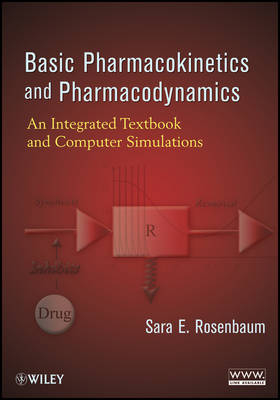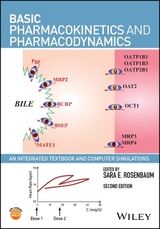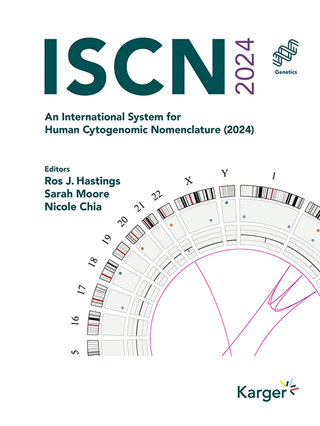
Basic Pharmacokinetics and Pharmacodynamics
Wiley-Blackwell (Verlag)
978-0-470-56906-1 (ISBN)
- Titel erscheint in neuer Auflage
- Artikel merken
As a result, you'll find it easy to gain an accurate, working knowledge of all the core principles, apply them to optimize dosing regimens, and evaluate the clinical pharmacokinetic and pharmacodynamic literature.
Sara E. Rosenbaum, PhD, is Professor of Biomedical and Pharmaceutical Sciences at the University of Rhode Island, where she teaches courses in pharmacokinetics. She is also the former editor-in-chief of Clinical Research and Regulatory Affairs. Dr. Rosenbaum's research interests concentrate on the development and application of pharmacokinetic and pharmacodynamic models that build our understanding of the drug dose-response relationship.
Preface. 1. Introduction to Pharmacokinetics and Pharmacodynamics. 1.1 Introduction: Drugs and Doses. 1.2 Introduction to Pharmacodynamics. 1.3 Introduction to Pharmacokinetics. 1.4 Dose-Response Relationships. 1.5 Therapeutic Range. 1.6 Summary. 2. Passage of Drugs Through Membranes. 2.1 Introduction. 2.2 Structure and Properties of Membranes. 2.3 Passive Diffusion. 2.4 Carrier-Mediated Processes: Transport Proteins. 3. Drug Administration, Absorption, and Bioavailability. 3.1 Introduction: Local and Systemic Drug Administration. 3.2 Common Routes of Systemic Drug Administration. 3.3 Overview of Oral Absorption. 3.4 Extent of Drug Absorption. 3.5 Determinants of the Bioavailability. 3.6 Factors Controlling the Rate of Drug Absorption. 3.7 Biopharmaceutics Classification System. Problems. References. 4. Drug Distribution. 4.1 Introduction. 4.2 Extent of Drug Distribution. 4.3 Rate of Drug Distribution. 4.4 Distribution of Drugs to the Central Nervous System. Problems. References. 5. Drug Elimination and Clearance. 5.1 Introduction. 5.2 Clearance. 5.3 Renal Clearance. 5.4 Hepatic Clearance. 5.5 Measurement of Clearances. Problems. References. 6. Compartmental Models in Pharmacokinetics. 6.1 Introduction. 6.2 Expressions for Component Parts of the Dose-Plasma. 6.3 Putting Everything Together: Compartments and Models. 6.4 Examples of Complete Compartment Models. 6.5 Use of Compartmental Models to Study Metabolite Pharmacokinetics. 6.6 Selecting and Applying Models. Problems. Recommended Reading. 7. Pharmacokinetics of an Intravenous Bolus Injection in a One-Compartment Model. 7.1 Introduction. 7.2 One-Compartment Model. 7.3 Pharmacokinetic Equations. 7.4 Simulation Exercise. 7.5 Application of the Model. 7.6 Determination of Pharmacokinetic Parameters Experimentally. 7.7 Pharmacokinetic Analysis in Clinical Practice. Problems. Recommended Reading. 8. Pharmacokinetics of an Intravenous Bolus Injection in a Two-Compartment Model. 8.1 Introduction. 8.2 Tissue and Compartment Distribution of a Drug. 8.3 Basic Equation. 8.4 Relationship Between Macro and Micro Rate Constants. 8.5 Primary Pharmacokinetic Parameters. 8.6 Simulation Exercise. 8.7 Determination of the Pharmacokinetic Parameters of the Two-Compartment Model. 8.8 Clinical Application of the Two-Compartment Model. Problems. Recommended Reading. 9. Pharmacokinetics of Extravascular Drug Administration. 9.1 Introduction. 9.2 Model for First-Order Absorption in a One-Compartment Model. 9.3 Bioavailability. 9.4 Simulation Exercise. Problems. Recommended Reading. 10. Introduction to Noncompartmental Analysis. 10.1 Introduction. 10.2 Mean Residence Time. 10.3 Determination of Other Important Pharmacokinetic Parameters. 10.4 Different Routes of Administration. 10.5 Application of Noncompartmental Analysis to Clinical Studies. Problems. 11. Pharmacokinetics of Intravenous Infusion in a One-Compartment Model. 11.1 Introduction. 11.2 Model and Equations. 11.3 Steady-State Plasma Concentration. 11.4 Loading Dose. 11.5 Termination of Infusion. 11.6 Individualization of Dosing Regimens. Problems. 12. Multiple Intravenous Bolus Injections in the One-Compartment Model. 12.1 Introduction. 12.2 Terms and Symbols Used in Multiple-Dosing Equations. 12.3 Monoexponential Decay During a Dosing Interval. 12.4 Basic Pharmacokinetic Equations for Multiple Doses. 12.5 Steady State. 12.6 Basic Formula Revisited. 12.7 Pharmacokinetic-Guided Dosing Regimen Design. 12.8 Simulation Exercise. Problems. References. 13. Multiple Intermittent Infusions. 13.1 Introduction. 13.2 Steady-State Equations for Multiple Intermittent. 13.3 Monoexponential Decay During a Dosing Interval: Dtermination of Peaks, Troughs, and Elimination Half-Life. 13.4 Determination of the Volume of Distribution. 13.5 Individualization of Dosing Regimens. 13.6 Simulation Exercise. Problems. 14. Multiple Oral Doses. 14.1 Introduction. 14.2 Steady-State Equations. 14.3 Equations Used Clinically to Individualize Oral Doses. 14.4 Simulation Exercise. Problems. 15. Nonlinear Pharmacokinetics. 15.1 Linear Pharmacokinetics. 15.2 Nonlinear Processes in Absorption, Distribution, Metabolism, and Elimination. 15.3 Pharmacokinetics of Capacity-Limited Metabolism. 15.4 Phenytoin. Problems. References. 16. Introduction to Pharmacodynamic Models and Integrated Pharmacokinetic-Pharmacodynamic Models. 16.1 Introduction. 16.2 Classic Pharmacodynamic Models Based on Traditional Receptor Theory. 16.3 Empirical Pharmacodynamic Models Used Clinically. 16.4 Integrated PK-PD Models: Emax Models Combined with a PK Model for Intravenous Bolus Infection in a One-Compartment Model. 16.5 Hystersis and the Effect Compartment. Problems. References. 17. Mechanism-Based Integrated Pharmacokinetic-Pharmacodynamic Models. 17.1 Introduction. 17.2 Alternative Models for Drug-Receptor Interaction: Operational Model of Agonism. 17.3 Physiological Turnover Model and Its Characteristics. 17.4 Indirect Effect Models. 17.5 Transduction and Transit Compartment Models. 17.6 Tolerance Models. 17.7 Irreversible Drug Effects. 17.8 Disease Progression Models. Problems. References. Appendix A. Review of Exponents and Logarithms. Appendix B. Rates of Processes. Appendix C. Creation of Excel Worksheets for Pharmacokinetic Analysis. Appendix D. Derivation of Equations for Multiple Intravenous Bolus Injections. Appendix E. Summary of the Properties of the Fictitious Drugs Used in the Text. Appendix F. Computer Simulation Models. Glossary of Abbreviations and Symbols. Index.
| Zusatzinfo | Illustrations |
|---|---|
| Verlagsort | Hoboken |
| Sprache | englisch |
| Maße | 177 x 252 mm |
| Gewicht | 816 g |
| Themenwelt | Medizin / Pharmazie ► Medizinische Fachgebiete |
| Studium ► 2. Studienabschnitt (Klinik) ► Humangenetik | |
| Naturwissenschaften ► Chemie | |
| ISBN-10 | 0-470-56906-9 / 0470569069 |
| ISBN-13 | 978-0-470-56906-1 / 9780470569061 |
| Zustand | Neuware |
| Informationen gemäß Produktsicherheitsverordnung (GPSR) | |
| Haben Sie eine Frage zum Produkt? |
aus dem Bereich



